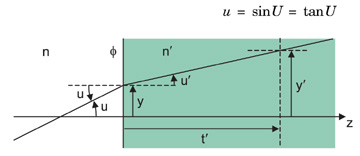Optipedia • SPIE Press books opened for your reference.
Paraxial Optics
Excerpt from Field Guide to Geometrical Optics
Paraxial optics is a method of determining the first-order properties of an optical system that assumes all ray angles are small. A paraxial raytrace is linear with respect to ray angles and heights since all paraxial angles u are defined to be the tangent of the actual angle U. Rays in the vicinity of the optical axis are used, and the surface sag is ignored or negligible.

Refraction (or reflection) occurs at an interface between two optical spaces. The transfer distance t' allows the ray height y' to be determined at any plane within an optical space (including virtual segments).


Refraction or reflection:
Transfer:
This type of raytrace is also called an YNU raytrace. All rays propagate from object space to image space. A reverse raytrace allows the ray properties to be determined in the optical space upstream of a known ray segment. A ray can then be worked back to its origins in object space.
 Refraction or reflection (reverse):
Refraction or reflection (reverse):
Transfer (reverse):
J. E. Greivenkamp, Field Guide to Geometrical Optics, SPIE Press, Bellingham, WA (2004).
View SPIE terms of use.

